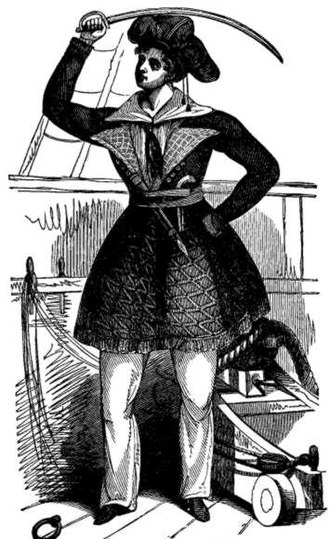Awilda, also known as Alwilda, was a female pirate. The story of Awilda is doubted by some historical scholars and considered to be a legend.

Legend
editAwilda was the daughter of a 5th-century Scandinavian king;[1][2] referred to in one source as Synardus and a "Gothic king".[3] It is said[by whom?] that the King, her father, had arranged a marriage for her to Alf, the crown prince of Denmark,[2] whose father was King Sygarus of Denmark.[3] However, Awilda refused her father's choice.[2][3] She and some of her female friends dressed like sailors and commandeered a ship.[2][3] While sailing, they came across a pirate ship that had recently lost its captain, and the pirates elected Awilda as their captain.[2][3] The King of Denmark sent his son and a navy ship to battle with the "irksome" pirates.[2][3] Prince Alf and his men were able to board their ship and gain the upper hand in the battle.[2][3] Apparently, Awilda was so impressed with the prince's courage that she revealed her true identity, and agreed to marry Alf.[2][3] They married on board, and lived happily ever after as King and Queen of Denmark.[3]
Modern versions
editItalian poet Torquato Tasso writes his most famous tragedy on her story, called Re Torrismondo, where Alwida is promised in marriage to the king of Sweden, Germondo, but falls in love with Torrismondo, so she decides to commit suicide in order not to choose between love and honor.
Mention in 1769 dictionary
editPassage from William Falconer's Dictionary of the Marine - under entry for Pirate:
"Amongst the most celebrated pirates of the north is recorded Alvilda, daughter of a king of the Goths, named Sypardus. She embraced this occupation to deliver herself from the violence imposed on her inclination, by a marriage with Alf, fon of Sigarus, king of Denmark. She dressed herself as a man and composed her band of rowers, and the rest of her crew, of a number of young women, attired in the same manner. Amongst the first of her cruises, she touched at a place where a company of pirates bewailed the death of their captain. The strangers were captivated by Alvilda's agreeable manners and chose her as their chief. By this reinforcement, she became so formidable upon the sea, that Prince Alf came to engage her. She sustained his attacks for a considerable time; but, in a vigorous action, Alf boarded her vessel, and having killed the greatest part of her crew, seized the captain, namely herself; whom nevertheless he knew nor, because the princess had a casque which covered her visage. Being master of her person, he removed the casque, and in spite of her disguise, instantly recognized her, and offered her his hand in wedlock. See Hist. Denmark, by Saxo Grammaticus.[4]
See also
editReferences
edit- ^ Samuel Astley Durham, History of Denmark, Sweden, and Norway, Volume 3, The cabinet cyclopaedia, p. 317 (Longman, Orme, Brown, Green & Longmans and John Taylor, 1840). Found at Google books. Retrieved September 16, 2010.
- ^ a b c d e f g h Skadi Meic Beorh (2009), Pirate Lingo, Wildside Press LLC, p. 9, ISBN 978-1-4344-0510-4 Found at Google books. Retrieved September 16, 2010.
- ^ a b c d e f g h i Ellms, Charles. "The Pirates Own Book (c. 1837)". Gutenberg books online. Retrieved September 16, 2010.
- ^ "03 Mar 2011 - William Falconer's Dictionary of the Marine, P, page 958 - Archived Website". Trove. Retrieved 2024-04-29.
External links
edit